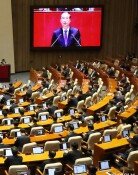Long-term policies less reliant on cash needed to tackle low birthrate
Long-term policies less reliant on cash needed to tackle low birthrate
Posted February. 09, 2024 07:34,
Updated February. 09, 2024 07:34
At a meeting of Seoul city officials, Seoul Mayor Oh Se-hoon said, "Attempts to boost the birth rate through cash payments will end this year. We should now focus on policies that create a society conducive to raising and nurturing children." On Wednesday, Mayor Oh posted on his Facebook page instructing officials to prepare for proactive policy tasks that include both bold childbirth incentives and future-oriented measures. In his post, he vowed to anticipate and prepare proactively. Amid the slew of cash subsidies to tackle plummeting birth rates, this journalist resonated with the mayor’s direction to break away from the current policy trend.
Seventeen years ago, during the 17th presidential election, candidate Heo Kyeong-young's pledge to provide 100 million won to newlyweds seemed unrealistic and absurd. However, the policy of supporting childbirth with 100 million won has become a common practice nowadays.
Incheon announced the '100-Million Plus I Dream' program last December, pledging to provide a total of 100 million won for every child born in Incheon until they reach the age of 18. Following this, the municipal office of Geochang County, Southern Gyeongsang Province, came up with a measure providing 110 million won per newborn, and Yeongdong County, North Chungcheong Province, announced a plan to offer up to 124 million won. Even private companies joined in, with Buyoung Group promising 100 million won per child born to employees with children born after 2021.
The low birth rate policy of Haenam County in South Jeolla Province was once hailed as the 'miracle of the village at the end of the land.' When the population dropped below 100,000 in 2000, the town has given 3 million won in cash for childbirth since 2012, increasing the childbirth encouragement fund from 500,000 to 3 million won, the highest in the country. Within just a year, the number of births increased by over 300, reaching 810, and the birth rate recorded 2.47, the highest among local governments nationwide. Until 2018, Haenam County maintained its position as the locality with the highest birth rate. What is problematic, however, is that one out of four families that received the childbirth encouragement fund left Haenam County. Parents felt that Haenam’s parenting, education, and healthcare infrastructure was insufficient, so they chose to move to better places to raise their children.
While any incentive should be better than no incentives, the exorbitant amount of subsidies might not necessarily address the concerns of working mothers. One mother in her 40s complained, "It's not that we can't have children because we don't have money. How can we find the time to raise them and send them to school? It's daunting." This comment highlights the importance of infrastructure that allows even double-income parents to leave their children and work comfortably. The bold imagination that gave birth to ‘100 million won cash subsidies’ should be applied to other new policies designed to expand parental leave and increase childcare and education facilities.







